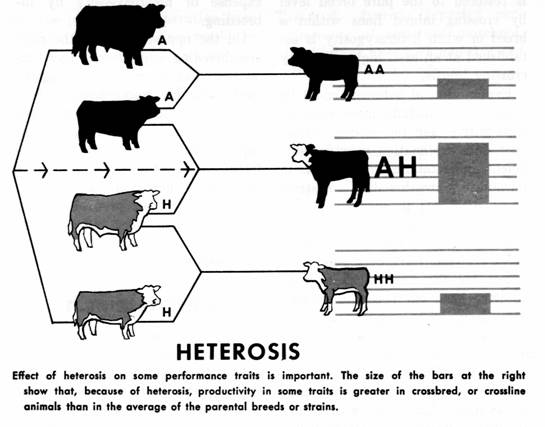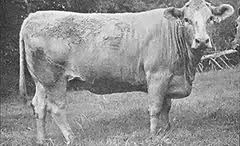
- •Institute of ecological safety
- •Heterosis
- •Introduction
- •Molecular basis of heterosis
- •Animal heterosis
- •3.1 Hybrid livestock
- •3.2 Humans
- •3.3 Plants
- •3.3.1 Corn (maize)
- •3.3.2 Rice (Oryza sativa)
- •4. Practical application of heterosis
- •4.1 Methods of inducing heterosis
- •4.1.1 Combining ability
- •4.1.2 Periodic selection
- •4.1.3 Convergent improvement
- •4.1.4 Cumulative selection
- •4.1.5 Gamete selection
- •4.2 Retention of heterosis
- •5.Conclusion
Animal heterosis
One example of where particular genes may be important in vertebrate animals for heterosis is the major histocompatibility complex. Vertebrates inherit several copies of both MHC class I and MHC class II from each parent, which are used in antigen presentation as part of the adaptive immune system. Each different copy of the genes is able to bind and present a different set of potential peptides to T-lymphocytes. These genes are highly polymorphic throughout populations, but will be more similar in smaller, more closely related populations. Breeding between more genetically distant individuals will decrease the chance of inheriting two alleles which are the same or similar, allowing a more diverse range of peptides to be presented. This therefore gives a decreased chance that any particular pathogen will not be recognised, and means that more antigenic proteins on any pathogen are likely to be recognised, giving a greater range of T-cell activation and therefore a greater response. This will also mean that the immunity acquired to the pathogen will be against a greater range of antigens, meaning that the pathogen must mutate more before immunity is lost. Thus hybrids will be less likely to be succumbing to pathogenic disease and will be more capable of fighting off infection. [7]

Figure 2. Types of heredity. Scenario A. Fewer genes are under-expressed in the homozygous individual. Thus, gene expression in the organism is equal to the best parent expression. Over dominance hypothesis. Scenario B. Over expression of certain genes in the homozygotes.
3.1 Hybrid livestock
The concept of heterosis is also applied in the production of commercial livestock. In cattle, hybrids between Black Angus and Hereford produce a hybrid known as a "Black Baldy". In swine, "blue butts" are produced by the cross of Hampshire and Yorkshire. Other, more exotic hybrids such as "beefalo" are also used for specialty markets. [1]


Figure 3. Beefalo- result of heterosis (hybridization between cow and bison)
Within poultry, sex-linked genes have been used to create hybrids in which males and females can be sorted at one day old by color. Specific genes used for this are genes for barring and wing feather growth. Crosses of this sort create what are sold as Black Sex-links, Red Sex-links, and various other crosses that are known by trade names.
Commercial broilers are produced by crossing different strains of White Rocks and White Cornish, the Cornish providing a large frame and the Rocks providing the fast rate of gain. The hybrid vigor produced allows the production of uniform birds with a marketable carcass at 6–9 weeks of age. [3]

Figure 4. Broiler or Leghorn Hen (are chickens Gallus gallus domesticus bred and raised specifically for meat production)
Likewise, hybrids between different strains of White Leghorn are used to produce laying flocks that provide the majority of white eggs for sale in the United States. [7]
3.2 Humans
Experimental breeding of humans is considered unethical, so any evidence of heterosis in humans is derived from observational studies.[8] It has been suggested that many beneficial effects on average health, intelligence, and height have resulted from an increased heterosis, in turn resulting from increased mixing of the human population such as by urbanization.[9] Diverse human populations commonly have a cultural rule or norm that prohibits sexual relations between relatives. Such a prohibition is referred to as an incest taboo. An effect of the incest taboo is to promote heterosis and avoidance of congenital birth defects that often result from expression of deleterious recessive alleles in children from matings between close relatives. [8]
